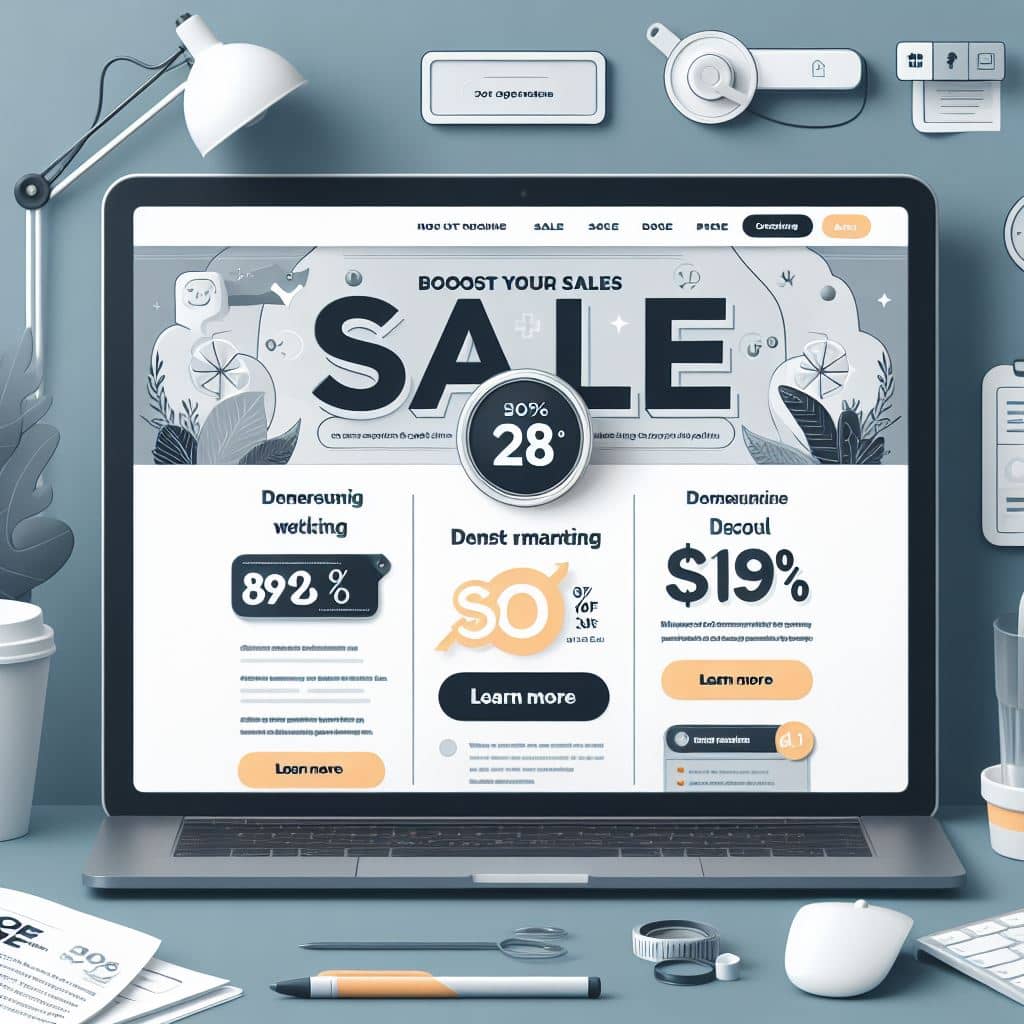How to Effectively Create and Distribute Content that Leads to Conversions and Sales.
In today's digital-first world, content marketing has emerged as a pivotal element in the ecommerce landscape. It's no longer just about showcasing products; it's about creating narratives that resonate with consumers, building brand loyalty, and establishing a digital presence that stands out in a crowded online marketplace. For ecommerce businesses, content marketing is not just a tool for engagement; it's a strategic asset that can significantly drive sales and conversions.
A well-crafted content marketing strategy goes beyond mere advertising; it involves creating valuable, relevant, and consistent content aimed at attracting and retaining a clearly defined audience. When executed effectively, this strategy not only informs and entertains but also gently guides potential customers through the buying journey. From informative blog posts and engaging social media content to compelling product descriptions and persuasive email campaigns, each piece of content serves as a stepping stone towards converting casual browsers into loyal customers.
In this dynamic environment, understanding how to leverage content marketing can make the difference between an ecommerce business that thrives and one that merely survives. As we delve deeper into this article, we'll explore the key components of a successful content marketing strategy for ecommerce, offering insights and practical tips on how to harness its power to boost your online sales and conversions.
Understanding Your Audience
In the realm of ecommerce, the key to a successful content marketing strategy lies in a deep understanding of your target audience. Knowing who your customers are, what they need, and how they behave online is crucial for crafting content that resonates and converts.
The Importance of Identifying Your Target Audience
- Targeted Content Creation: Understanding your audience ensures that the content you create is relevant and appealing to those who are most likely to purchase your products. It helps in addressing their specific needs, pain points, and preferences.
- Increased Engagement and Loyalty: When customers find content that speaks directly to their interests and needs, they are more likely to engage with your brand and remain loyal over time.
- Efficient Use of Resources: By knowing your audience, you can allocate your marketing resources more effectively, focusing on strategies and channels that yield the best results.
Creating Buyer Personas
- Gather Data: Start by collecting data on your existing customers through surveys, social media interactions, and website analytics. Look for common characteristics, behaviors, and interests.
- Develop Personas: Create detailed buyer personas that represent different segments of your audience. Each persona should include demographic details, behavioral traits, motivations, and any other relevant information.
- Use Personas to Guide Content Creation: Utilize these personas to guide your content creation process. For instance, if one of your personas is a tech-savvy millennial, you might focus on creating content that highlights the latest tech features of your products.
Tailoring Content to Meet Audience Needs
- Personalized Content: Use the insights from your buyer personas to personalize your content. This could mean creating different types of content for different personas or tailoring the messaging in your ads and social media posts.
- Addressing Pain Points: Ensure your content addresses the specific pain points and challenges of your target audience. For example, if a common concern is product durability, create content that showcases the quality and longevity of your products.
- Engaging Formats: Experiment with different content formats – such as videos, blogs, infographics, or podcasts – to see what resonates best with your audience. Different personas may prefer different types of content.
In conclusion, understanding your audience is the foundation upon which effective ecommerce content marketing is built.
By identifying your target audience, creating detailed buyer personas, and tailoring your content to meet their specific needs, you can create a content marketing strategy that not only attracts attention but also drives meaningful engagement and sales.
Creating Valuable and Relevant Content
In the competitive world of ecommerce, the creation of original, high-quality content is not just a recommendation; it's a necessity. Content that provides genuine value to the audience can set your brand apart, build trust, and ultimately drive conversions and loyalty.
The Imperative of Original and High-Quality Content
- Building Brand Authority: High-quality content establishes your brand as an authority in your niche. It demonstrates expertise and builds trust with your audience, which is crucial for long-term customer relationships.
- Enhancing User Engagement: Original and engaging content captures the attention of your audience and keeps them interested in your brand. This engagement is key to nurturing leads and guiding them through the buyer's journey.
- Improving SEO Rankings: Search engines favor unique and valuable content. By providing content that is both informative and relevant, you improve your chances of ranking higher in search results, thereby increasing visibility and traffic.
Strategies for Creating Diverse Content Types
Blogs: Develop a blog strategy that covers topics relevant to your audience's interests and needs. Use blogs to provide in-depth information, how-to guides, industry insights, and product usage tips. Ensure your blogs are SEO-optimized with relevant keywords without compromising readability.
Videos: Leverage the power of video content to demonstrate products, share customer testimonials, or give a behind-the-scenes look at your brand. Videos are highly engaging and can be shared across various platforms, including social media and YouTube.
Infographics: Create infographics to present data, guides, or product comparisons in a visually appealing and easily digestible format. Infographics are great for conveying complex information succinctly and are highly shareable, making them excellent for social media engagement.
Interactive Content: Consider interactive content like quizzes, polls, or calculators. This type of content not only engages users but also provides valuable insights into their preferences and behaviors.
Email Content: Craft compelling email content that nurtures leads and keeps your audience informed about new products, offers, and content. Personalize your emails based on customer behavior and preferences to increase open rates and engagement.
In summary, the creation of valuable and relevant content in various formats is essential for any successful ecommerce content marketing strategy.
By consistently providing high-quality, original content tailored to your audience's interests, you can effectively engage customers, enhance your brand's reputation, and drive meaningful results for your ecommerce business.
SEO Optimization for Ecommerce Content
In the digital marketplace, where competition is fierce and attention spans are short, the role of SEO (Search Engine Optimization) in content marketing cannot be overstated. For ecommerce businesses, SEO is the linchpin that can significantly amplify the reach and impact of their content, driving more traffic, enhancing visibility, and ultimately contributing to sales success.
The Crucial Role of SEO in Ecommerce
- Driving Organic Traffic: SEO helps in optimizing your content to rank higher in search engine results pages (SERPs), making it more likely for potential customers to find your ecommerce site when they search for products or information related to your niche.
- Building Credibility and Trust: High rankings in search results are often perceived as endorsements by search engines. This visibility not only increases traffic but also builds credibility and trust with potential customers.
- Long-Term Success: Unlike paid advertising, the benefits of SEO are long-lasting. Well-optimized content continues to drive traffic and generate sales long after it has been published.
Best Practices for Keyword Research
- Understand Your Audience’s Search Intent: Start by understanding the search queries your potential customers are using. This involves identifying not just the right keywords but also the intent behind these searches.
- Use Keyword Research Tools: Leverage tools like Google Keyword Planner, SEMrush, or Ahrefs to find relevant keywords with high search volumes and low to medium competition.
- Consider Long-Tail Keywords: Incorporate long-tail keywords in your content strategy. These are more specific, less competitive, and often have higher conversion rates as they align closely with the user’s intent.
Integrating SEO into Content Creation
- Optimize Titles and Meta Descriptions: Ensure your content titles and meta descriptions are compelling and include your primary keywords. They should entice users to click through while accurately representing the content.
- Quality Content with Strategic Keyword Placement: Create high-quality, informative content where keywords are naturally integrated. Avoid keyword stuffing; instead, focus on creating content that flows naturally and is valuable to the reader.
- Optimize Images and Videos: Use descriptive, keyword-rich file names and alt text for images and videos. This not only helps in SEO but also improves accessibility.
- Mobile Optimization: With the increasing use of mobile devices, ensure your content is mobile-friendly. Google’s mobile-first indexing means your site’s mobile version is crucial for rankings.
- Internal Linking: Use internal links to guide users to related content on your site. This not only enhances user experience but also helps search engines crawl and index your content more effectively.
- Regular Updates and Refreshes: Keep your content updated and relevant. Regularly revisiting and updating your content can help maintain its rankings in search results.
Incorporating these SEO best practices into your ecommerce content strategy is essential for maximizing its reach and effectiveness. By optimizing your content for search engines, you not only enhance its visibility but also improve the user experience, both of which are key to driving conversions and achieving ecommerce success.
Leveraging Social Media and Email Marketing
In today's digital age, social media and email marketing are powerful tools for ecommerce businesses, playing a crucial role in content distribution, customer engagement, and driving traffic to online stores.
The Power of Social Media in Content Distribution
- Expanding Reach: Social media platforms offer a vast audience for your content. By sharing your content on these platforms, you can significantly expand your reach beyond your existing customer base.
- Enhancing Engagement: Social media encourages interaction. Posts can be liked, commented on, and shared, creating a dynamic environment for engaging with your audience and fostering a community around your brand.
- Targeted Advertising: Platforms like Facebook, Instagram, and Twitter offer advanced targeting options for advertising. You can use these to promote your content to specific demographics, interests, and behaviors, ensuring it reaches the most relevant audience.
- Visual Appeal: Social media is highly visual. Utilize eye-catching images, videos, and graphics to make your content stand out and capture the attention of potential customers as they scroll through their feeds.
Effective Email Marketing Strategies
- Personalized Communication: Email marketing allows for personalized communication with your audience. Use customer data to segment your email list and tailor your messages based on their preferences and past interactions with your brand.
- Driving Traffic to Your Site: Include clear calls-to-action in your emails that direct recipients to your ecommerce site, whether it’s to read a blog post, check out a new product, or take advantage of a special offer.
- Regular Newsletters: Send out regular newsletters to keep your audience informed about the latest content, products, and news from your brand. This keeps your audience engaged and encourages repeat visits to your site.
- Abandoned Cart Emails: Implement abandoned cart emails to remind customers of items they left in their cart. These emails can include content that persuades them to complete their purchase, such as product benefits, customer testimonials, or a limited-time discount.
- Measuring Success: Use email analytics to track open rates, click-through rates, and conversions. This data can help you understand what types of content and offers resonate best with your audience, allowing you to refine your email strategy for better results.
In conclusion, leveraging social media and email marketing is essential for any comprehensive ecommerce content marketing strategy.
These channels not only help in distributing and promoting your content but also play a vital role in building relationships with your audience, enhancing brand loyalty, and driving traffic and sales for your ecommerce site.
Personalizing the Ecommerce Experience
In the competitive ecommerce landscape, personalization has become a key differentiator in enhancing customer experience and boosting sales. Personalized content caters directly to individual customer preferences and behaviors, creating a more engaging and relevant shopping experience.
The Impact of Personalized Content
- Enhanced Customer Engagement: Personalized content resonates more deeply with customers. By tailoring content to individual interests and needs, you increase engagement, which can lead to higher customer satisfaction and loyalty.
- Increased Conversion Rates: Personalized content is more effective in guiding customers through the buying process. By presenting products and offers that align with their preferences, you increase the likelihood of conversion.
- Building Long-Term Relationships: Personalization helps in building long-term relationships with customers. It shows that you value and understand them, which can encourage repeat business and positive word-of-mouth.
Techniques for Personalizing Content Across Digital Platforms
- Data-Driven Personalization: Utilize customer data from various touchpoints – such as browsing history, purchase history, and social media interactions – to create a comprehensive understanding of each customer’s preferences.
- Segmentation and Targeting: Segment your audience based on demographics, behavior, or purchase history. Create targeted content for these segments, such as personalized email campaigns or social media ads.
- Dynamic Website Content: Implement dynamic content on your ecommerce site. This could include personalized product recommendations, tailored banners, or customized landing pages based on the visitor’s past interactions.
- Personalized Email Campaigns: Use email marketing tools to send personalized emails. This can range from addressing customers by name to recommending products based on their previous purchases.
- Social Media Personalization: Leverage social media platforms to deliver personalized content. This can include targeted ads based on user interests or engaging with customers directly through comments or messages.
- AI and Machine Learning: Employ AI and machine learning technologies to automate and enhance personalization. These technologies can analyze large sets of data to predict customer preferences and deliver highly personalized content experiences.
- Testing and Optimization: Continuously test and optimize your personalization strategies. Use A/B testing to determine what types of personalized content yield the best results and adjust your approach accordingly.
Incorporating personalization into your ecommerce content strategy is not just about selling products; it’s about creating a unique and memorable shopping experience that resonates with each customer.
By effectively personalizing content across different digital platforms, you can significantly enhance the customer experience, leading to increased loyalty, higher conversion rates, and ultimately, greater sales success.
Analyzing and Optimizing Content Performance
In the digital age, the success of your ecommerce content marketing strategy hinges on your ability to analyze and optimize content performance.
Utilizing tools like Google Analytics is essential for gaining insights into how your content resonates with your audience and drives business objectives.
The Role of Analytics in Content Performance
- Track User Engagement: Use Google Analytics to track key metrics such as page views, time spent on page, bounce rate, and user engagement. This data provides a clear picture of how visitors interact with your content.
- Conversion Tracking: Set up goals in Google Analytics to track conversions. Whether it’s newsletter sign-ups, product purchases, or contact form submissions, understanding what content drives these conversions is crucial.
- Traffic Sources: Analyze where your traffic is coming from. Understanding whether visitors are coming from organic search, social media, email, or paid ads can help you allocate resources more effectively.
Tips for Refining Content Strategy
- Identify High-Performing Content: Look at which pieces of content are performing best and try to understand why. Use these insights to replicate this success in future content.
- Optimize Underperforming Content: For content that’s not performing well, consider revising or repurposing it. Sometimes, small tweaks in headlines, keywords, or layout can make a big difference.
- A/B Testing: Regularly conduct A/B tests on various elements of your content to see what resonates best with your audience. This could include testing different headlines, images, or call-to-actions.
- Adapt Based on Trends: Stay agile and be ready to adapt your content strategy based on the data. If certain topics or formats become more popular, adjust your content plan accordingly.
Utilizing Ecommerce Platforms and Tools
Ecommerce platforms and tools play a pivotal role in streamlining and enhancing your content marketing efforts. Understanding and integrating these tools can significantly boost the efficiency and effectiveness of your strategy.
Overview of Ecommerce Tools
- Content Management Systems (CMS): Platforms like WordPress, Shopify, or Magento offer robust CMS capabilities tailored for ecommerce, making it easier to create, manage, and publish content.
- SEO Tools: Tools like SEMrush, Ahrefs, or Moz provide valuable insights into keywords, backlinks, and competitor analysis, which are essential for SEO optimization.
- Social Media Management Tools: Platforms like Hootsuite or Buffer help in scheduling and analyzing your social media content, ensuring consistent presence and engagement.
Integrating Tools into Your Strategy
- Seamless Integration: Ensure that your chosen tools integrate seamlessly with each other and with your ecommerce platform. This integration is key to a cohesive content marketing strategy.
- Automate Where Possible: Use automation tools to save time and resources. Automation can be used for tasks like email marketing, social media posting, and even some aspects of content creation.
- Data-Driven Decision Making: Leverage the data from these tools to make informed decisions about your content strategy. Regularly review the insights provided and use them to guide your content creation and distribution efforts.



